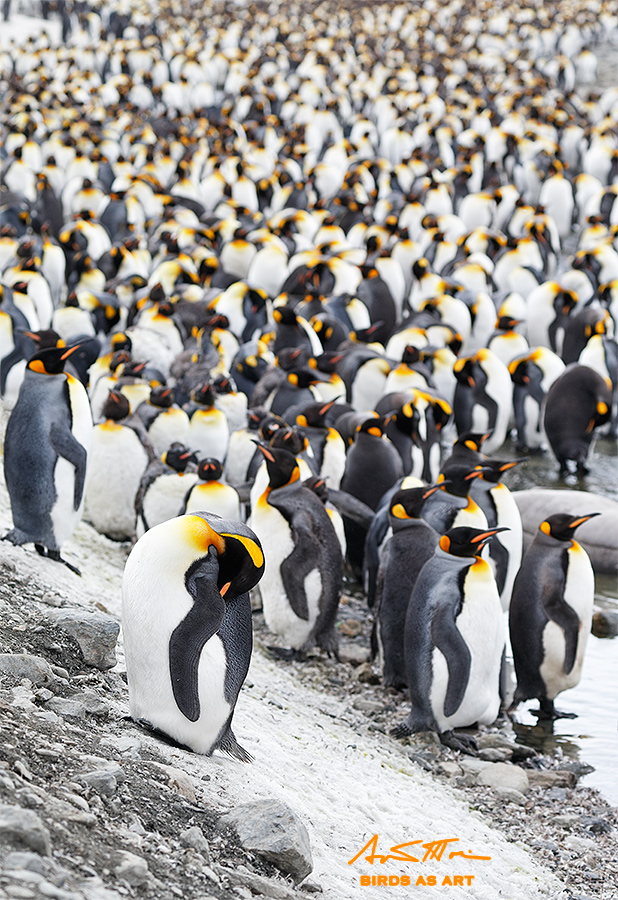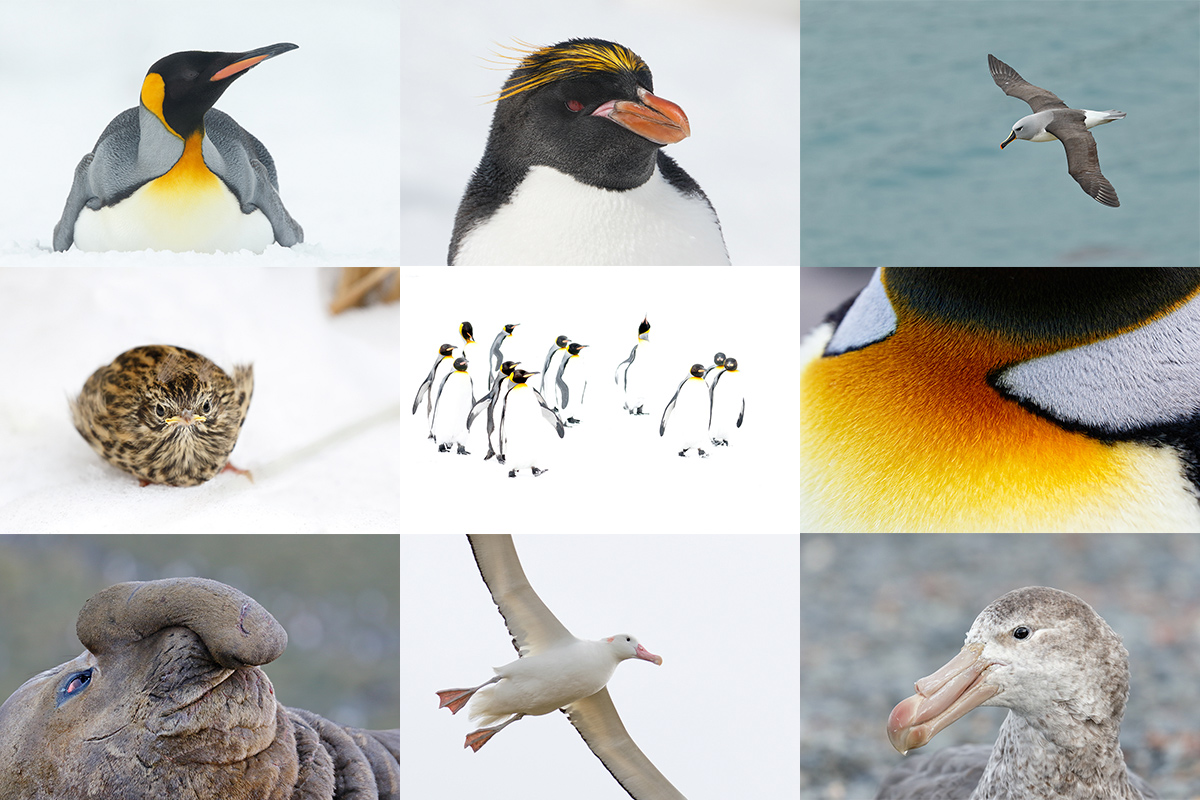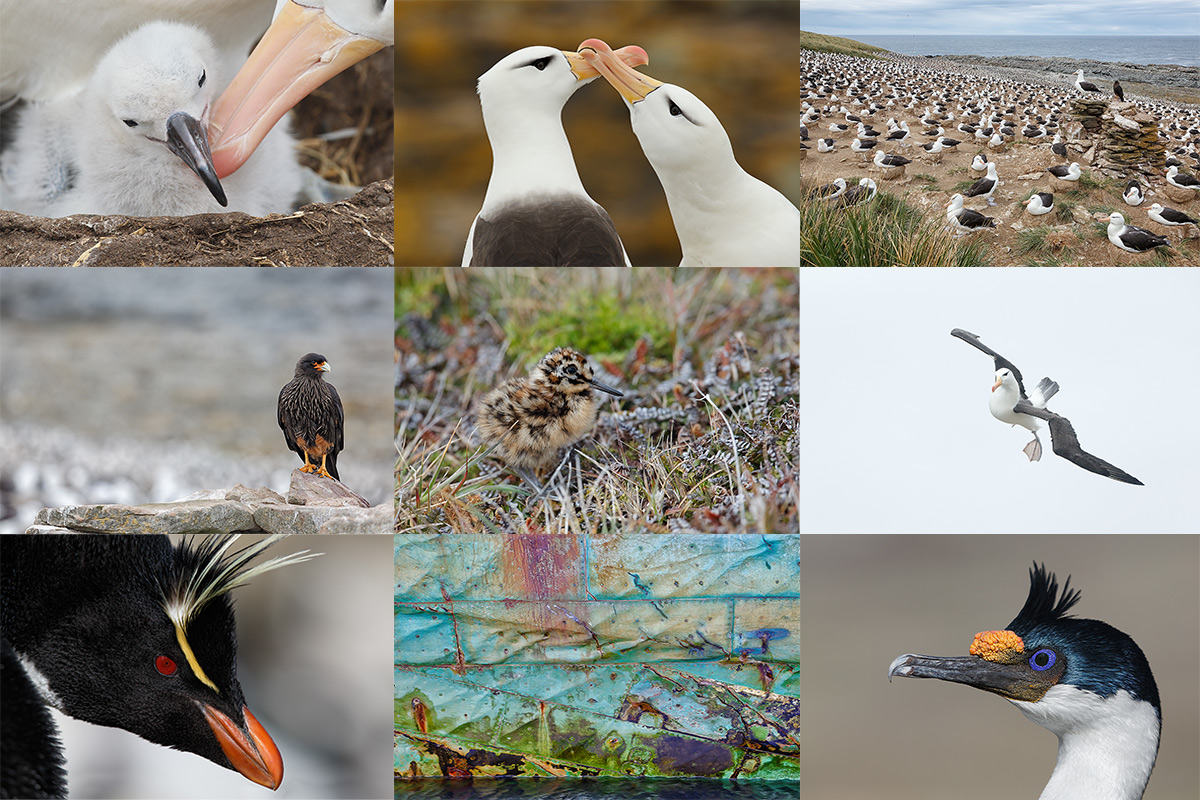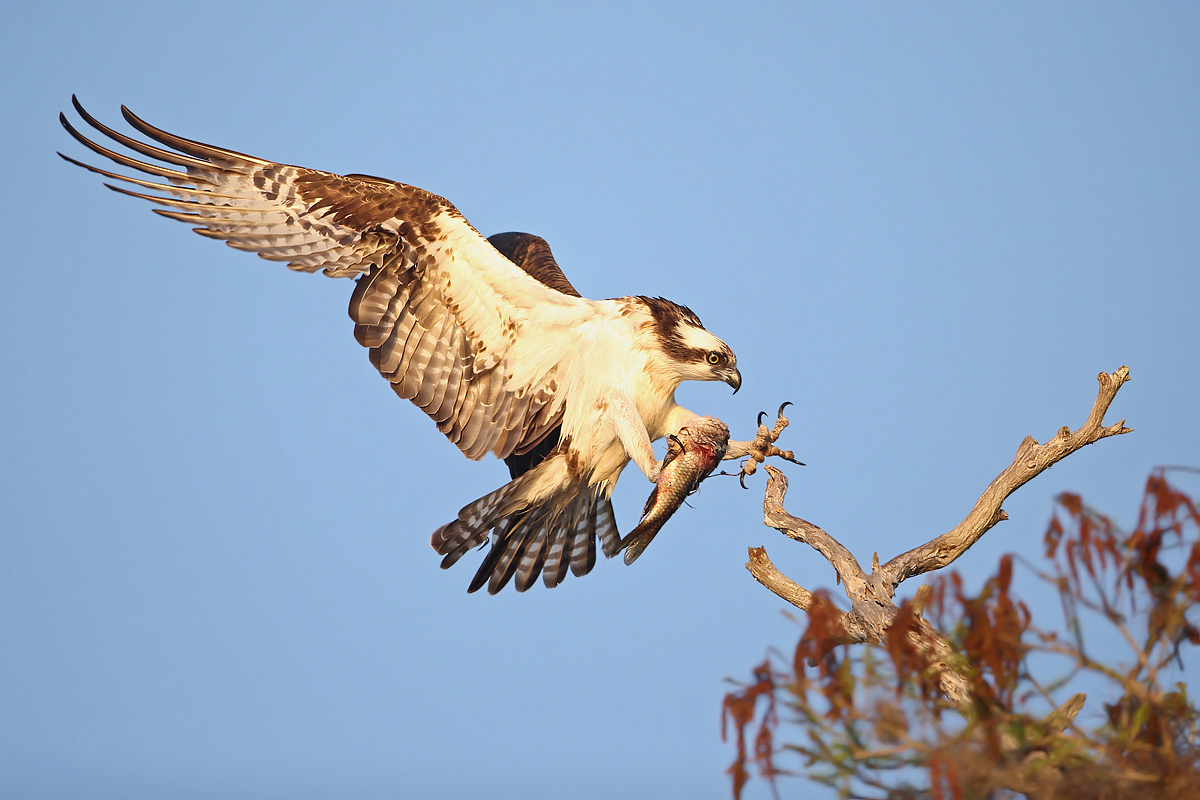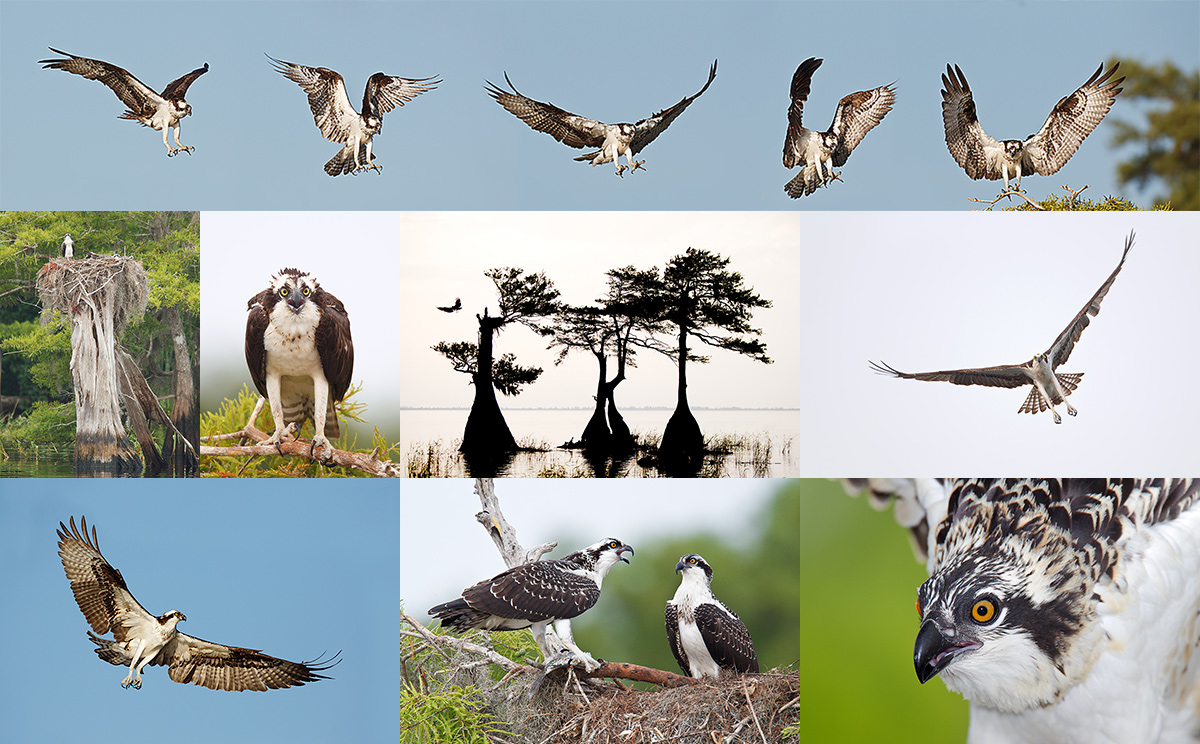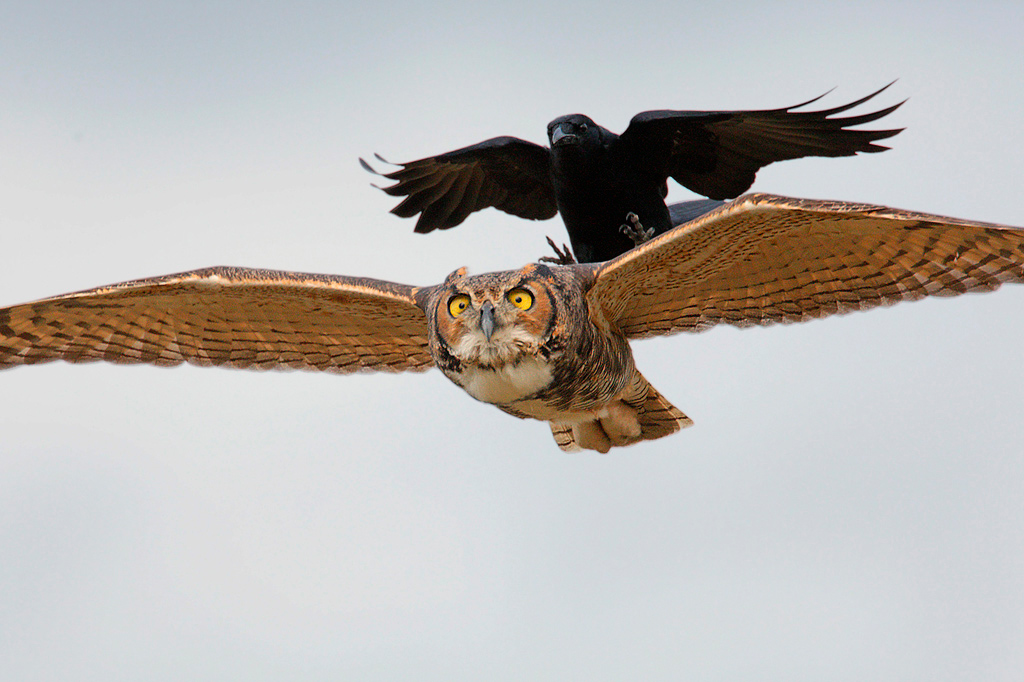- Lessons on Photographing Piles of Penguins…
- The 2016 OCT/NOV Cheesemans’ South Georgia/Falklands Expedition: Their and my last one!
- Jim Neiger Flight School Photography: Osprey Heaven Workshops
- Your Help Needed and Appreciated/Affiliate Stuff
|
This image was created at St. Andrews Bay, South Georgia on the fabulous 2015 OCT/NOV Cheesemans’ South Georgia Expedition with the hand held Canon EF 100-400mm f/4.5-5.6L IS II USM lens at 135mm and the rugged Canon EOS-1D X. ISO 400. Evaluative metering +1/3 stop: 1/640 sec. at f/6.3. AWB. Center AF point/AI Servo Expand/Rear Focus AF on the closest penguin in the lower left of the frame and re-compose. Click here to see the latest version of the Rear Focus Tutorial. Click on the image to see a larger version. Penguins by the stream, St. Andrews Bay |
Lessons on Photographing Piles of Penguins…
Photographing the huge assemblages of King Penguins on the Salisbury Plains and St. Andrews Bay landings on a Southern Oceans expedition is not as easy as it might seems. There are so many birds that you need to pay attention to lots of small but important details. Keep reading to learn a ton.
- Get as high a vantage point as possible. This might include climbing atop a ridge or a large hill or simply getting on top of a mound of tussock grass. For today’s featured image I was able to get nicely above the birds by being on the bank of a small river: every it bit of elevation helps.
- Unless you are doing a frame filling pure pattern shot, strive for a clean lower edge as above.
- Zoom lenses are really helpful when it comes to framing. Take extreme care when it comes to checking the left and right frame-edges… Small crops and a bit of Photoshop edge cleanup can work wonders as they did with the image above.
- Working on a tripod can really help with careful framing; remember to do as I say not as I do 🙂
- Try to find a close bird that is distinctive either by position or pose so that it can serve as a compositional anchor, as the bird in the lower left did for today’s image.
- Consider the options and choose your perspective carefully.
- As far as the upper frame edge, at times it is possible to have a clean upper edge but often, as here, the birds will simply disappear out of the frame especially if you are working at a wide aperture.
- Speaking of f/stops, your best option when hand holding is to work wide open or close to it. If you are on a tripod and the birds are resting or sleeping, you have the option of going to a tiny aperture and trying to get lots of depth of field with the range of sharpness extending either well back in the frame or actually covering all of the birds; this is largely a function of your focal length and how far away from the birds you are.
|
All images on the card were created on the 2015 Cheesemans’ South Georgia Expedition. From top left clockwise to center: King Penguin resting on Snow, Fortuna Bay; Macaroni Penguin in snow, Cooper Island; Grey-headed Albatross, Elsehul; King Penguin neck abstract, Godthul; Northern Giant Petrel, Undine Harbor; adult Wandering Albatross, Prion Island; Elephant Seal, Undine Harbor; South Georgia Pipit fledgling/thanks Joe Kaplan! Fortuna Bay; high key King Penguins in snow, Fortuna Bay. Card design and all images copyright 2015: Arthur Morris/BIRDS AS ART |
The Cheesemans’ 2016 OCT/NOV South Georgia/Falklands Expedition
If reading last Saturday’s blog post here put a thought in your mind about joining the BIRDS AS ART group on the Cheesemans’ 2016 OCT/NOV South Georgia/Falklands Expedition, please shoot me an e-mail with the words “Cheesemans’ Last South Georgia Expedition” cut and pasted into the Subject Line with any questions or if you wish to receive additional inspiration. This will surely be my last ship-based trip to the South Georgia as well.
|
All of the images on this card were created in the Falklands on the 2014 Cheesemans’ Southern Oceans Expedition. From top left clockwise to center: Black-browed Albatross tending chick, Steeple Jason Island; Black-browed Albatross courting pair, New Island; the Black-browed Albatross colony at Steeple Jason Island; Black-browed Albatross landing, New Island; King Cormorant head portrait, New Island; hull detail/derelict minesweeper, New Island; Rockhopper Penguin head portrait in bright sun, New Island; Striated Caracara, Steeple Jason Island; Magellanic Snipe chick, Sea Lion Island. |
An Expedition Overview
Experience the vibrant spring of South Georgia, a true Antarctic wildlife paradise. Observe and photograph wildlife behaviors seldom seen beneath the towering, snow-blanketed mountains that dominate the island’s landscape. Southern Elephant Seal bulls fight for breeding rights while females nurse young, overlook vast colonies of loafing King Penguins, watch Macaroni Penguins cavort in the snow, photograph handsome Gray-headed Albatrosses in flight or attending to their cliffside nests and awkward Wandering Albatrosses attempting first flight. The itinerary includes six landing days on South Georgia and three landing days in the Falklands to observe too cute Rockhopper Penguins, Magellanic Penguins standing watch at their nesting burrows, and more Black-browed Albatrosses than you could ever imagine. To commemorate Shackleton’s famous self-rescue crossing South Georgia, CES also offers an optional trek retracing his steps. With Cheesemans’ twenty years of experience in the Antarctic region, they commit to an in-depth exploration of one of the densest wildlife spectacles found anywhere in the world, and with only 100 passengers, they routinely give you the opportunity to completely immerse yourself on each landing.
Two of the scheduled Falklands’ landings, New Island and especially Steeple Jason Island, rival the best locations on South Georgia. Those will likely include Salisbury Plain, St. Andrews Bay, Elsehul, Fortuna Bay, and either Cooper Island or Hercules Bay (for Macaroni Penguins).
Why Sign Up Through BIRDS AS ART?
If you have been thinking and dreaming of finally visiting South Georgia, this is the trip for you. There will likely never be another trip like this as the best outfit in the Southern Oceans business will not be returning after 2016…. Quit dreaming and act now. Though I will not be an expedition staff member on this trip, those who have traveled with me know that I cannot help but teach. And I will be doing a introductory photography program for the entire ship on our crossing to South Georgia. All who sign up via BAA will receive a free copy the new Southern Ocean Photography Guide (a $100 value) that I am currently working on. It will include pre-trip gear and clothing recommendations and a ton of info that you will find to be invaluable.
I will hold informal pre-landing briefings aboard ship so that when you land you know exactly what to expect and where to go. I will be available on the ship to review your images, answer your questions, and conduct informal over-the shoulder Photoshop sessions. And best of all, everyone who signs up under the auspices of BAA are invited to tag along with me on the landings where I will be glad to offer invaluable in-the-field advice. And the same goes for the shipboard birds in flight and marine mammal photographic sessions.
Again, if you would like to join me on what will truly be a once in a lifetime opportunity to a wondrous place, please shoot me an e-mail with the words “Cheesemans’ Last South Georgia Expedition” cut and pasted into the Subject Line.
You can learn more about the trip here. If you sign up on your own be sure to mention that you would like to be part of the BAA Group. I’d be glad to answer any and all question via e-mail or by phone at 863-692-0906.
Important Notes
#1: If you fail to e-mail me as noted directly above, and register directly with CES you MUST let them know that you would like to be part of the BIRDS AS ART group.
#2: Joining the BIRDS AS ART group as above will not cost you one penny.
For additional details on the trip and the ship, see Saturday’s blog post here.


Please Remember to use our Affiliate Links 🙂
To show your appreciation for my continuing efforts here, we ask, as always, that you use our the B&H and Amazon affiliate links on the right side of the blog for all of your purchases. B&H is recommended for you major photography gear purchases, Amazon for your household, entertainment, and general purpose stuff. Please check the availability of all photographic accessories in the BIRDS AS ART Online Store, especially the Mongoose M3.6 tripod heads, Gitzo tripods, Wimberley heads and plates, LensCoats and accessories, and the like. We sell only what I have used, have tested, and can depend on. We will not sell you junk. We know what you need to make creating great images easy and fun. And we are always glad to answer your gear questions via e-mail. I just learned that my account was suspended during my absence; it should be up and running by Monday at the latest.
I would of course appreciate your using our B&H affiliate links for all of your major gear, video, and electronic purchases. For the photographic stuff mentioned in the paragraph above we, meaning BAA, would of course greatly appreciate your business. Here is a huge thank you to the many who have been using our links on a regular basis and visiting the BAA Online store as well.
Be sure to like and follow BAA on Facebook by clicking on the logo link upper right. Tanks a stack!
Typos
In all blog posts and Bulletins, feel free to e-mail or to leave a comment regarding any typos or errors. Just be right 🙂
|
Osprey landing with fish. Image copyright 2013: Jim Neiger/Flight School Photography |
Jim Neiger’s Osprey Heaven Workshops 2016
Lake Blue Cypress (Vero Beach), Florida
Flight School Photography returns to Lake Blue Cypress for the seventh year and will be featuring two, five day workshops in spring, 2016. The workshops will be conducted by expert bird photographer Jim Neiger, who knows the lake and surrounding area like no-one else. Jim has spent the past several years perfecting his unique techniques for photographing birds in flight using large telephoto lenses, hand held. The focus of these workshops will be learning Jim’s hand held, long lens techniques for photographing birds in flight and in other action. The workshops will be held in some of the most beautiful, wild, and unspoiled wilderness areas of central Florida.
Each workshop will include a four hour classroom session, welcome dinner, four morning photography sessions, and three afternoon photography sessions. Each photography session will be of three to four hours in duration. Five of the photography sessions will be conducted via a specially configured pontoon boat that has been customized for photography from the water (weather permitting). The remaining photography sessions will be land based sessions in the field. The workshops will be limited to five participants so that everyone may photograph in comfort and receive personalized instruction.
The photography sessions by boat will be held on the unspoiled and unparalleled Lake Blue Cypress. This spectacularly beautiful lake is virtually free of civilization and man made elements. The lake is surrounded by ancient cypress swamp and marshy wetlands. Here, the gorgeous cypress trees grow from the lake bottom, surrounded on all sides by water. Osprey nest by the hundreds in these trees, and participants will be able to photograph them as the fly to and fro, dive for fish, gather nesting materials, and feed their young chicks. Some of the nests are actually at or below eye level when standing in the boat. The only distraction in this pristine, wilderness environment is the constant cries of the Osprey as they frolic in the air and defend their nests from other birds.
Lake Blue Cypress is also a landscape photographers dream. The horizons contain nothing of man’s influence and only the beauty of the real Florida wilderness. Perches and backgrounds are spectacular beyond belief. March and April are the best months to be at Lake Blue Cypress. Many of the birds are actively nesting and rearing their young during this time. Wildflowers cover the stumps and trees like blankets of radiant color. The skies glow with spectacular, multi-hued sunrises and sunsets. Hundreds of different species of birds are possible including the typical Florida waders and water fowl. Large Alligators are commonly seen sunning themselves on top of the fallen trees and stumps amidst the colorful wildflowers. The biggest problem for a photographer here is deciding which subject to photograph. Even the weather cooperates this time of year. It is the dry season and clear, sunny days are the most common weather condition.
|
These are artie’s images from Lake Blue Cypress trips with Jim Neiger. |
The photography sessions on land will be held in remote areas of southern Osceola County. Here, participants are likely to have opportunities to photograph birds that are endangered and rarely seen. Possible species include: Whooping Cranes, Swallow-tailed Kites, Great Horned Owls, Barred Owls, and Red Shoulder Hawks, among others. Sandhill Cranes, a common bird in Central Florida, are tame enough to approach as closely as you like. Participants will also learn how to safely use bird song recordings to attract birds. Jim has developed his own, innovative techniques for using recordings to attract birds, in such a way, that amazing photographic opportunities are common when they would be almost impossible otherwise. This includes special techniques that encourage birds to fly and land in desired ways, which provide spectacular opportunities for flight images and images on perches chosen for their beauty.
Jim consistently produces amazing flight images. His imagination and dedication have resulted in his developing many new techniques, techniques that can only be learned from Jim. His Flight School Photography Workshops are a must for any serious nature photographer. artie
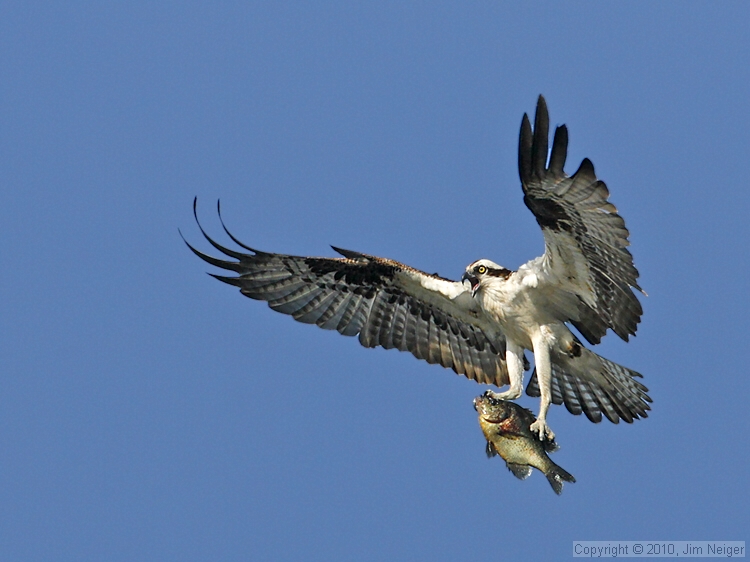
|
|
Osprey landing with bream. Image copyright 2013: Jim Neiger/Flight School Photography |
Workshop Dates
Workshop LBC-1: April 17-21, 2016
Workshop LBC-2: April 24-28, 2016
Workshop Itinerary
Day 1 (afternoon/evening ): Morning arrival in Vero Beach, which is the base location for the workshops. There will be a four hour classroom session from 2:00pm to 6:00pm in the hotel meeting room. This will be followed by a welcome dinner with the group. The classroom instruction will focus on using hand held techniques for photographing birds in flight to prepare participants for the subsequent photography sessions.
Days 2: Morning photography session via boat on Lake Blue Cypress. Mid-day siesta and lunch break on your own. Afternoon/evening photography session on Lake Blue Cypress. Late dinner on your own.
Day 3: Morning photography session via boat on Lake Blue Cypress. Mid-day siesta and lunch break. Afternoon/evening photography session on Lake Blue Cypress. Late dinner on your own.
Day 4: Mini caravan to land locations for morning photography session. Mid-day siesta and lunch break. Afternoon/evening photography session. Dinner on your own.
Day 5 (morning): Morning photography session via boat on Lake Blue Cypress.
Please note: The itinerary may be re-arranged to take advantage of the best weather conditions for photography sessions by boat.
Workshop Costs and Payment
The cost of each workshop is $1750 per person. Each workshop includes a four hour formal classroom instruction session, a welcome dinner, 4 morning photography sessions, and 3 afternoon photography sessions. The photography sessions include personalized instruction in the field. Each participant will receive a copy of Jim’s e-book “Flight Plan – How to Photograph Birds in Flight” when they sign up for the workshop. Discounted lodging is available, but is not included in the workshop fee. A $875 non-refundable deposit is required to reserve a spot in a workshop. The remaining $875 is due 30 days before the start date of the workshop. If you are unable to attend the workshop, after paying the balance, the balance payment will be refunded ONLY if your spot can be filled, on short notice, from the waiting list. All workshop payments must be made by check or money order. Credit cards are not accepted.
Participant Requirements
Participants should have working knowledge of how to create a properly exposed image, a telephoto lens of 400mm or more (300mm with a teleconverter is acceptable), and be physically capable of holding their camera and lens up to their eye in shooting position for at least 20 seconds. Participants must also have a vehicle to travel to and from the photography locations.
Lodging and Logistics
Workshop participants who require lodging during the workshop should stay at the hotel in Vero Beach where the classroom sessions will be conducted. Participants arriving via air arrive at the Orlando International Airport, which is the closest major airport to Vero Beach. Rental vehicles are available at the airport. Flight School Photography will assist participants with arranging the sharing of vehicles and/or lodging if desired. Detailed information will be provided when you sign up for the workshop or upon request. Lodging, transportation, and meals (except for welcome dinner) are not included.
Learn more here. View Jim’s incredible image gallery here. And see some of artie’s images here.
|
Great Horned Owl being harassed by Fish Crow. BBC Honored image copyright: Jim Neiger/Flight School Photography |
Flight School Custom Anytime Workshops
Flight School Photography offers private, customized workshops, September thru May, in some of the most beautiful, wild, and unspoiled areas of central Florida. Your instructor and guide, Jim Neiger, has spent several years observing, studying, and photographing the varied birds near his home in central Florida and knows this avian rich area like no one else. If you prefer, Jim will travel to a location selected by you to provide personal instruction.
These individual or small group workshops are tailored exclusively to the participants’ interests, goals, and schedule. Workshops are conducted by boat, on land, or a combination of both. Personalized instruction lets you make the most of your time. The workshops can range from a single half-day workshop to multi-day or week-long workshops. Snacks and drinks are provided during every workshop session.
You have the following options: scheduling a private, individual custom workshop; putting together a small group of photographers for a customized workshop; or having Jim travel to your location to provide a custom workshop. You can also choose the species you wish to focus on and/or the topics you would like to learn more about. Jim’s experience in the central Florida area allows him to locate the most sought after species in settings and conditions that are optimal for photography.
Custom Workshops by Boat
Jim’s pontoon boat was purchased and customized specifically for use during photography workshops. It is roomy, comfortable, and stable. The boat is equipped with an extremely quiet, four-stroke motor for silent cruising. It also has a powerful, silent, electric trolling motor with wireless remote control. This allows Jim to position the boat precisely and silently. The boat has a capacity of twelve people, but Jim limits the number of participants to five or less so that everyone has room to photograph in comfort. The boat can be configured with no top, a half canopy to provide shelter from sun and rain, or with a half enclosure that can completely protect participants from the elements. Using the boat allows close access to some of the most difficult and desirable subjects in North America. Many of the images of these subjects in their wetland habitat would not be possible from land.
Custom Workshops on Land
Land-based sessions are held in a number of wild and remote locations of central Florida. Jim has spent several years learning the out-of-the-way wilderness areas in the region. He has also written a best selling guide to photographing birds in central Florida. The variety of birds in the area is astounding; Jim knows where to find them and how best to photograph them. Participants will need to provide their own vehicle for the land-based workshops, unless there is only 1 photographer.
Both land and boat workshops are likely to provide participants with opportunities to photograph birds that are uncommon and rarely seen. Possible subjects include: Crested Caracara, Sandhill Cranes, Whooping Cranes, Barred and Great Horned Owls, Bald Eagles, Osprey, Snail Kites, Red-Shouldered Hawks, Red Cockaded Woodpeckers, Pileated Woodpeckers, Limpkins, Ibis, Wood Storks, Purple Gallinules, various wading birds, warblers, sparrows, and many others too numerous to list.
Custom Workshop Instruction
Custom workshops may also include personalized, in-the-field instruction; formal classroom instruction; or an introductory slide presentation, if desired. Topics may include instruction devoted to learning or practicing:
· Jim’s unique handheld techniques for photographing birds in flight using long telephoto lenses.
· Jim’s unique techniques for using recordings safely to attract and photograph birds successfully
· Making proper exposures working in manual exposure mode
· Other nature photography topics of your choice
Learn more about Jim’s Flight School Custom Anytime Workshops here. See the spectacular image gallery here. See the custom workshop rates here.
Contact Information
Contact Information: Jim Neiger, Flight School Photography, Inc. 550 Basin Drive, Kissimmee, FL 34744-4804
Cell phone: (407) 247-5200. e-mail.
Flight School website.
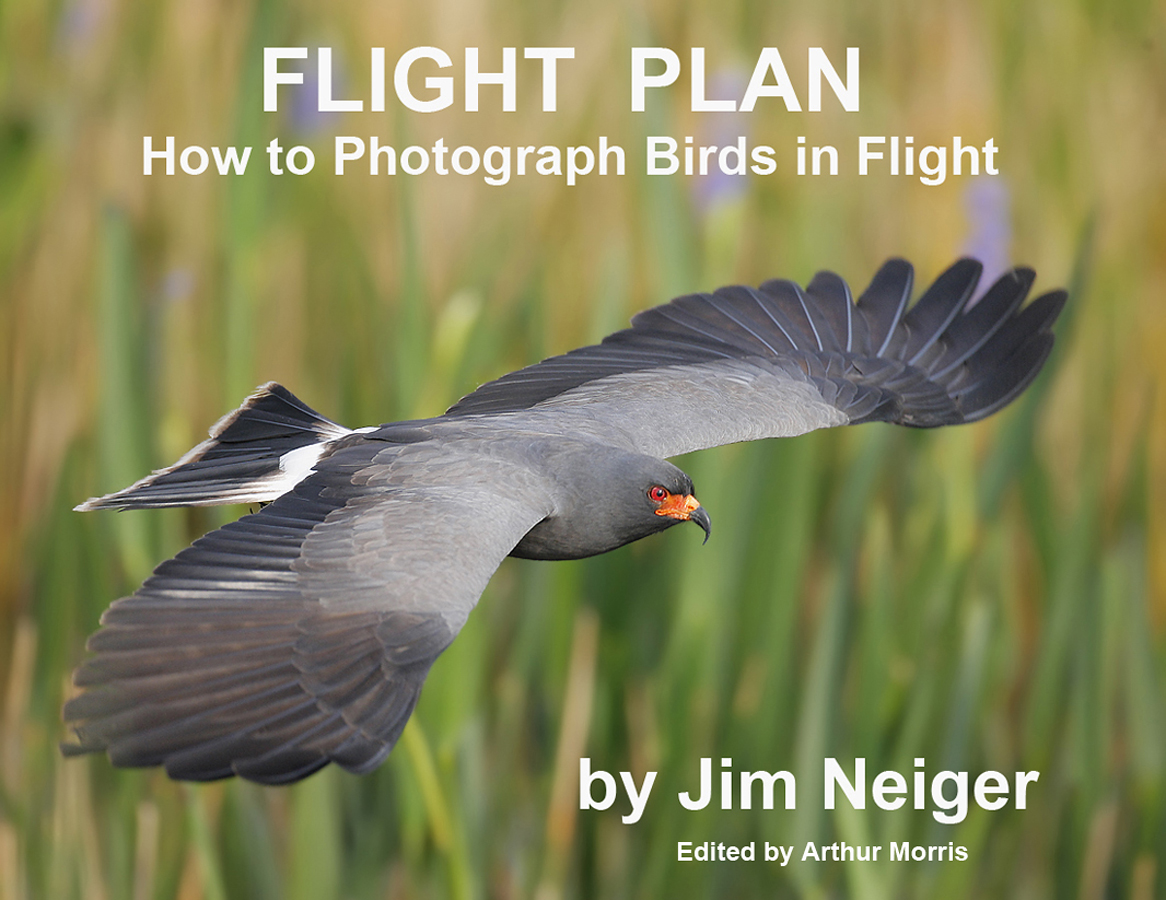
|
Flight Plan
I can say without a doubt that after spending more than two months (part time) editing Jim Neiger’s great e-Guide–Flight Plan–two years ago–that my flight photography improved by leaps and bound whether I am working off a tripod or hand holding. His explanation of the bumping the focus technique finally sunk in. Learning to use this technique regularly is a huge help for any all types of flight photography.
You can learn more about Flight Plan here or order a copy by clicking here.
Bob Hollowell’s Flight Plan Comments
I just wanted to send kudos to both you and Jim Neiger for the excellent E-book that you referenced in a recent BAA blog post. I immediately purchased a copy, and have finished my first read and will now read it a second time just to make sure I’m ready to take it to the field. My favorite haunt is Squaw Creek NWLR and I’ve stumbled & fumbled with flight photos using both tripod & monopod as support for my Canon 7D, and just can’t seem to come up with real sharp photos using that method. Jim’s text is well written, and really puts flight photography in a whole new perspective for me. I’m 76 years old, and I’m sure I’ll have to experiment with the handholding methodology a bit, but I’m excited at the prospect of applying Jim’s methods.
Thanks again… Bob H.
